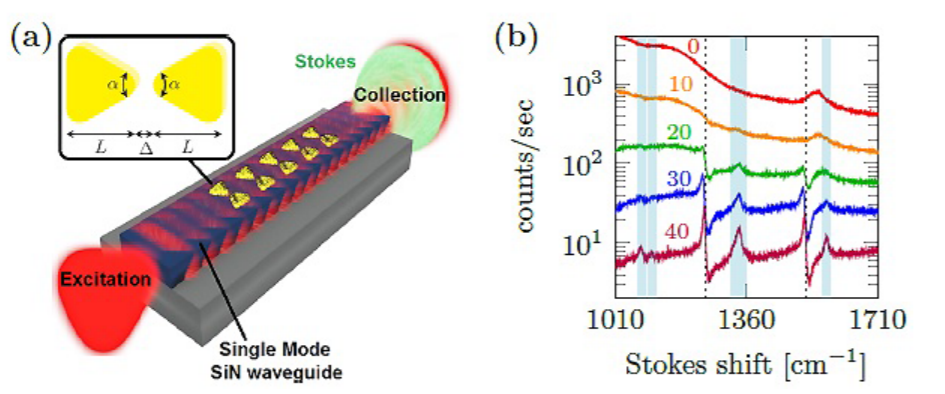Resources
 Part of the Oxford Instruments Group
Part of the Oxford Instruments Group
Expand
Collapse
 Part of the Oxford Instruments Group
Part of the Oxford Instruments Group
Surface Enhanced Raman Spectroscopy (SERS) is a promising technique for enhancing inherently weak Raman signals by introducing a plasmonic nanostructure in the vicinity of the analyte under study. Recently, photonic integrated circuits (PICs) emerged as a promising alternative to standard confocal microscopy to probe spontaneous Raman spectra. [1,2] The fundamental building block of such circuits is a single mode waveguide where the pump and Stokes light is guided in a high-index core material which is surrounded by lower-index cladding materials. In our study we demonstrated for the first time the generation of SERS signals from integrated bowtie nanoantennas, excited and collected by a single mode silicon nitride (SiN) waveguide. [2]
Using a system consisting of a Shamrock 303i spectrograph (SR-303i-A-SIL) and an iDus 416 CCD detector (DU416A-LDC-DD), we experimentally determined the enhanced Stokes power, generated by a single nanoantenna, which is coupled into the fundamental TE-mode. The theoretically predicted absolute Raman power perfectly corresponded with the experimentally observed power coupled into the fundamental TE-mode. The device under study is shown in Figure 1(a) and a description of the measurement setup can be found in the Supplementary Information of [2].
SERS spectra of waveguides patterned with a different number N of antennas were collected and are shown in Figure 1(b). For 1 W of guided power in the SiN waveguide, a single integrated nanoplasmonic antenna will generate about 2.6 fW of guided Stokes power. [2] Taking into account all transmission losses, the actual power reaching the detector surface is expected to be between 2.6x10-2 and 2.6x10-3 fW. Due to the inherently low readout and dark noise of the iDus 416, we were limited by the shot noise of the SiN Raman background signal (which is mainly generated in the SiN core). As a result, we were able to detect the smallest SERS peaks (power levels 10-2 – 10-3 fW) using a 1200 l/mm grating. From the N=40 curve in Figure 1(b) one can see that in case the SiN background is low (due to attenuation caused by the antennas), the overall noise is indeed extremely low. Since the SiN Raman background is huge for lower Stokes shifts, we only want to image the larger Stokes shifts where the relevant SERS peaks are in order to fully exploit the dynamic range of the detector. This is realized by the rotating grating turret of the Shamrock 303i which allows easy rotation of the gratings in order to image the relevant wavelength band on the detector. Moreover, the system allows easy wavelength calibration for our fibre input using the dedicated fibre holder with adjustable knobs for calibration.

Figure 1: (a) Schematic of the device: single mode silicon nitride (SiN) waveguide patterned with an array of nanoplasmonic bowtie antennas. (b) SERS spectra of waveguides coated with a different number N of antennas (10, 20, 30, 40), N=0 is a reference waveguide without antennas.
In conclusion, the iDus 416 camera is perfectly suited for detection of extremely weak Raman signals due to a combination of low readout noise and low dark current. The dark current can be further reduced by only reading out the relevant pixels instead of using the Full Vertical Binning option. Moreover, the overall system (Shamrock 303i and iDus 416) is very robust and easily controlled using the Andor Solis software.
[1] Dhakal, A., et al. Evanescent excitation and collection of spontaneous Raman spectra using silicon nitride nanophotonic waveguides. Opt. Lett. 2014, 39, 4025--4028.
[2] Peyskens, F., et al. Surface Enhanced Raman Spectroscopy Using a Single Mode Nanophotonic-Plasmonic Platform, ACS Photonics 2016, 3(1), 102--108.
Date: August 2016
Author: Dr. Frédéric Peyskens of the Photonics Research Group at the Center for Nano-and BioPhotonics, Ghent University
Category: Application Note
